|
|
Post by hughdeany on Oct 24, 2021 12:48:41 GMT 10
Hi Don,
For some reason I’m getting Globetrotter vibes from this one,don’t know why.😗
The cupboard doors and handles are exactly the same as Roadhaven used,I wonder if back then they bought from one supplier as they all do now.
Cheers
hughdeany
|
|
|
|
Post by jules34 on Feb 12, 2022 12:54:22 GMT 10
Hi I’m new to this site, joined today yesterday I hot a vintage caravan. I’m hoping you guys can help me identify it, year etc it’s got a name on it ‘Grump’?
The number plate is G45-130, there’s stickers of veg in the window from 1981.
On the door side there’s a sign Premier, on the frame at the front there’s a welded number 1904 - 6
|
|
|
|
Post by Don Ricardo on Feb 12, 2022 14:32:43 GMT 10
Hi Jules34,
Without yet having seen photos of your van, but based on the 'Premier' signage and the format of the serial number, I'm pretty sure that your van is a Franklin Premier built in 1966. The 1966 comes from the '-6' in the serial number and was the standard way Franklin identified the build year.
Not sure what 'Grump' refers to. Maybe it was the nickname of a previous owner or a nickname for the caravan? The registration number doesn't tell us anything much except that the van was probably registered in around 1967 when separate registration of vans was introduced in Victoria. But that doesn't correlate with the year of the van as such, because a lot of older vans had to be registered for the first time in that year as well.
Don Ricardo
|
|
|
|
Post by jules34 on Feb 12, 2022 16:02:44 GMT 10
Thanks Don, I’m using my phone and there doesn’t seem to be an option to add attachment on it so I’ll have to wait till I get on the laptop to send? Hoping that on the website on a computer it will allow me to add photos. It needs work. 😎 I’m wondering whether there anyone around wher I liv that might know about them and be able to help. I’m in ocean Grove Vic
|
|
|
|
Post by Don Ricardo on Feb 12, 2022 20:28:34 GMT 10
Hi Jules34,
You should be OK on a desktop or laptop computer. You will see the 'Add Attachment' button at the top right hand corner of the 'Create Post' box.
Do you mind telling me what sort of phone you have please? It sounds like we need to do a bit of work to see how/if we can make the button appear.
Don Ricardo
|
|
|
|
Post by Don Ricardo on Mar 11, 2022 15:24:28 GMT 10
REFERENCE NO: UC #45
A few weeks ago, Sportsman1 forwarded these photos he'd received from somebody else, wondering if we could identify the van. Sportsman1 wasn't able to, and neither Hughdeany nor I can either at this point:
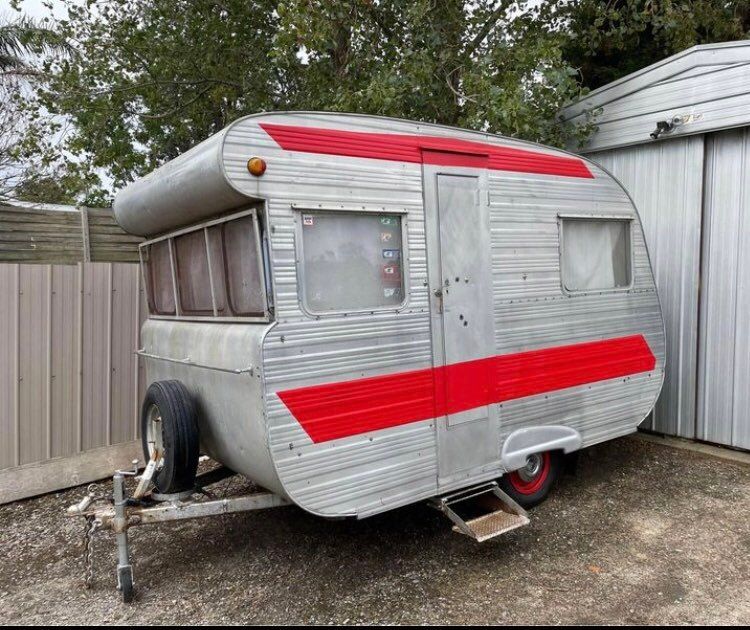
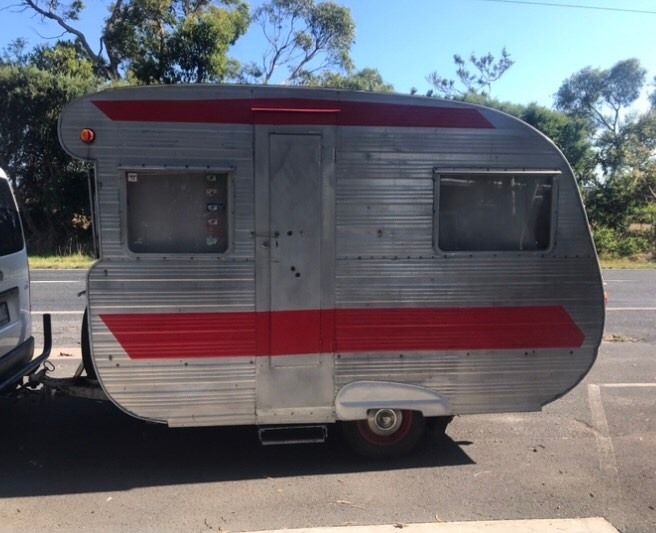
The interesting features of the van that should help identify it are the three windows across the front (that appear to have a guard of some sort in front of them), and the little 'lips' underneath thev an where the front and rear curve under the van to meet the floor.
The cladding suggests a build date of 1964+.
If you are able to tell us anything more about this caravan please post on this thread using the reference number so that we can connect your post to the caravan concerned.
Don Ricardo
|
|
|
|
Post by oldbinky on Sept 30, 2022 21:25:55 GMT 10
Hey this looks very similar to the one we are restoring
If I knew how to post picks I would
|
|
|
|
Post by Don Ricardo on Sept 30, 2022 23:10:21 GMT 10
Hi Oldblinky, That's definitely one way to get our attention!    What's the reference number of the caravan you're referring to? There are instructions on how to post photos on the forum if you click on this link. The easiest way is to use the 'Add Attachment' button, but note that there's an extra step you need to take to make it appear on your phone. We'll look forward to hearing more about your van. Don Ricardo |
|
|
|
Post by stevemoate on Oct 16, 2022 18:55:48 GMT 10
Hi there steve here just wondering if u know of any expanda vans for sale I had one and sold it to a couple around Newcastle they were at the vintage caravan show at Bulli nsw would like to purchase another one just thought I would ask regards Steve 0414470284
|
|
|
|
Post by arthur01 on Oct 20, 2022 15:40:04 GMT 10
Hi everyone I have been on this forum for about two weeks now trying to identify my grandfathers old caravan. I do believe it to be a Rowvan but I am not 100% sure a I haven't seen one like it. I will try and put up pics of the identifying features and a few others that may or may not help. any information would be helpful. _20221020_A.png?width=undefined&height=undefined&fit=bounds) _20221020_B.png?width=undefined&height=undefined&fit=bounds) _20221020_C.png?width=undefined&height=undefined&fit=bounds) |
|
|
|
Post by hughdeany on Oct 20, 2022 21:20:39 GMT 10
Hi and welcome Arthur,
Your van certainly looks like a Rowvan,especially the interior,the stove alcove and bottom hinged cupboards are a giveaway too.
Is it a flat roof or does it curve front to back and side to side?
Cheers
hughdeany
|
|
|
|
Post by arthur01 on Oct 21, 2022 7:32:36 GMT 10
Thanks for the information hughdeany I also think the same that the stove alcove would mean that it is a Rowvan. I think that the roof is flat and that is one of the reasons why I am asking for help. The van has other features that I have not read that others have or that I have seen in any pictures. Some are the stabilizing stands that are with it and that it has a stretcher for a bed that clips in above the dinning table
|
|
|
|
Post by hughdeany on Oct 21, 2022 13:20:58 GMT 10
Hi again Arthur,
Are the jacks tubular and slide inside a metal sleeve with a turn handle to lock? If so that was standard on a few vans,as was the canvas bunk.Don Ricardo will be able to tell us more about the flat curved roof I think.
Cheers
hughdeany
|
|
|
|
Post by arthur01 on Oct 21, 2022 15:11:27 GMT 10
Yes the jacks are as you described.
Look forwarded to learning more about it and try and work out what year it may have been built.
|
|
|
|
Post by Don Ricardo on Oct 21, 2022 15:58:15 GMT 10
Hi Arthur01, Welcome to the forum. It's great to see the photos of your grandfather's van which is pretty intriguing. I am afraid I am going to take a different tack to Hughdeany and say that your van isn't a Rowvan. That's always a bit dangerous because Hughdeany is mostly right about what he says, but I reckon I've got the evidence on my side this time around!    Your van does have a number of features of a Rowvan, in particular the straight external floorline without an external wheel arch, the curve of the roof when looked at from the side, porthole windows (which a number of other makes also had), the construction of the stove alcove with the slanted walls either side, and the general construction of the overhead cupboards. But at the same time there are quite a number of differences between your van and the Rowvans. These include: - The shape of the front - the front of your van above the lower point of the red stripe slants backwards towards the rear quite noticeably. The front of Rowvans from that point were almost perpendicular, ie almost no slant backwards.
- The shape of the rear - it's a bit hard to see from the angle of the photo, but the widest part of the curve at the rear of your van appears to be below the waist line of the van. The widest part of the curve at the rear of a Rowvan was at the waist line of the van.
- The shape of the roof - the roof of your van only curves from front to back, and not from side to side. The Rowvan rooves were double cambered, ie they curved from front to back as well as from side to side.
- Joining strip on the sides - your van doesn't have a strip on the external sides of the van covering a join in the cladding. Rowvans had a strip about two-thirds the way up the van.
- Front windows - the front windows on your van are not as wide as Rowvan models with the double windows, and your van also has a single rain channel above both windows, whereas Rowvans had a single channel for each window.
- Door - the door on your van is quite unusual amongst all caravans in that it has upper and lower opening hatches. Rowvan doors just had an opening window (not a hatch) in the top half of the door. The door on Rowvans also closed in the same plane as the wall, whereas your door closes a little proud of the wall and is surrounded with a shallow architrave.
- Floorline - at the front of your van the wall curves to meet the floorline without a discernible break. The rear may be the same, but I can't quite tell because of the tree. On Rowvans the front and rear walls did not curve into the floorline but joined the floor at an angle.
- Side stripe - if the paintwork on your van is original (and it may not be), it has the waist high, large red stripe. Rowvans were finished with a downward 'swoosh' on the sides.
- Jockey wheel handle - your jockey wheel handle has a double grip. Rowvans seem to have had a handle with just the single grip.
I presume you found the Rowvan thread in the 'Down History Lane' section of the forum here? If you look at the photos of the pre-1959/60 Rowvans there I think you will see what I mean with each of the above points. All of the above differences are relatively minor (except those relating to the shape), but I think taking them all together they are a pretty certain indicator that your van is not a Rowvan. It has been stated over the years that Bill Rowe used to contract out the finishing of some of his vans to other people, and that that accounts for some of the differences between Rowvans built by Bill Rowe and other caravans with a similar design. The problem is we haven't been able to verify that statement or identify any specific vans that were finished off by others. But even if we could, I don't think that would explain the origins of your van. The differences between your van and 'regular' Rowvans are too numerous and too significant in my view. Sorry if that all seems a bit disappointing in terms of identifying your van. But I can follow that up with a bit of encouraging news: we have seen another example of your van on the forum: 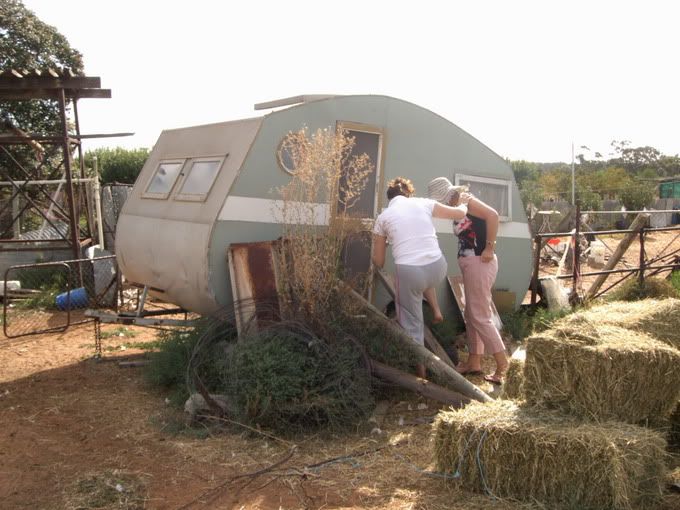 You can see that it has the same shape (especially the front and rear), the same single cambered roof, same front windows, same door with upper and lower hatches, and a similar coloured band on the side (although without the break in it underneath the window). Looking at the photo there does appear to be one difference, and that is that the green van seems to have an external wheel arch, whereas yours doesn't. But overall I don't think there's any doubt that the green van was built by the same manufacturer as yours. We had previously identified the green van as an early Globe here but I now have my doubts about that. I think the two vans were possibly built by one of the manufacturers in South Australia that we don't yet know much about. There are a few of those where we know names and some details but haven't yet been able to connect any actual caravans that we've seen, to them. That creates some problems because a lot of the South Australian vans in the 50's followed similar styling, and it is sometimes a bit hard to tell them apart. (As it happens Rowvan is a bit of an outlier on this point because their vans had a quite distinctive style, while still being identifiably from the South Australian caravan industry.) I would love to see some more photos of your van if you can post them: the rear, offside (driver's side), and some more photos of the inside (table, bed area, wardrobe, etc). That may provide some more clues. Also I have a couple of questions about your van. 1. Does the van have a 'tudor ceiling'? (A tudor ceiling is where the roof struts are visible inside under the ceiling. That was a feature of many, but not all, South Australian built caravans.) 2. How far back on the roof is the roof hatch located on your van? (Rowvans had their hatch located back beyond the mid point of the length of the van, whereas other vans had them either on the mid point or slightly to the front of the van as can be seen on the green van.) Although we haven't yet identified your van, hopefully the above will get us closer to an answer. Don Ricardo |
|
|
|
Post by hughdeany on Oct 22, 2022 21:08:13 GMT 10
Hi Don and Arthur,
Re the van in the pic being the same as Arthur’s I agree after looking through lots of Globe pics,but I think one thing will tell us,Rowvan had sliding jacks in a sleeve that were in situ and you turned a knob and the inner sleeve dropped to the ground,where you then did up the knob to stabilise.
Globetrotter for many years had a metal fitting at the rear corners that you put portable steel sleeves in and used the built in turning handle that made the Jack look like a T.The sleeves were not part of the rear fittings,but were carried loose in the van.
Just another thought,
Cheers
hughdeany
|
|
|
|
Post by Don Ricardo on Oct 23, 2022 17:32:32 GMT 10
Hi Hughdeany and Arthur1, That's a very interesting comment about the stabiliser legs, Hughdeany. I have done a bit of follow-up research and have made another astonishing discovery... Very few people post photos with the stabiliser legs down on the ground!! Even when the vans are unhitched from their tow vehicle and apparently in place for some time, they very rarely have their stabiliser legs down and/or visible, or so the photos suggest. Amazing. That last discovery is a bit of a red herring away from the discussion about the origins of Arthur01's caravan, so back to the main point. As I mentioned in a post above, I now have some fairly serious doubts about whether the green van and in fact the first three caravans shown in the Globe post I pointed Arthur01 to are actually Globes, but you may be right that the legs will provide extra evidence. Here is a photo of a Wayfarer branded Globe caravan from around the mid-50's which shows a clear photo of the type of Globe stabiliser legs you described: 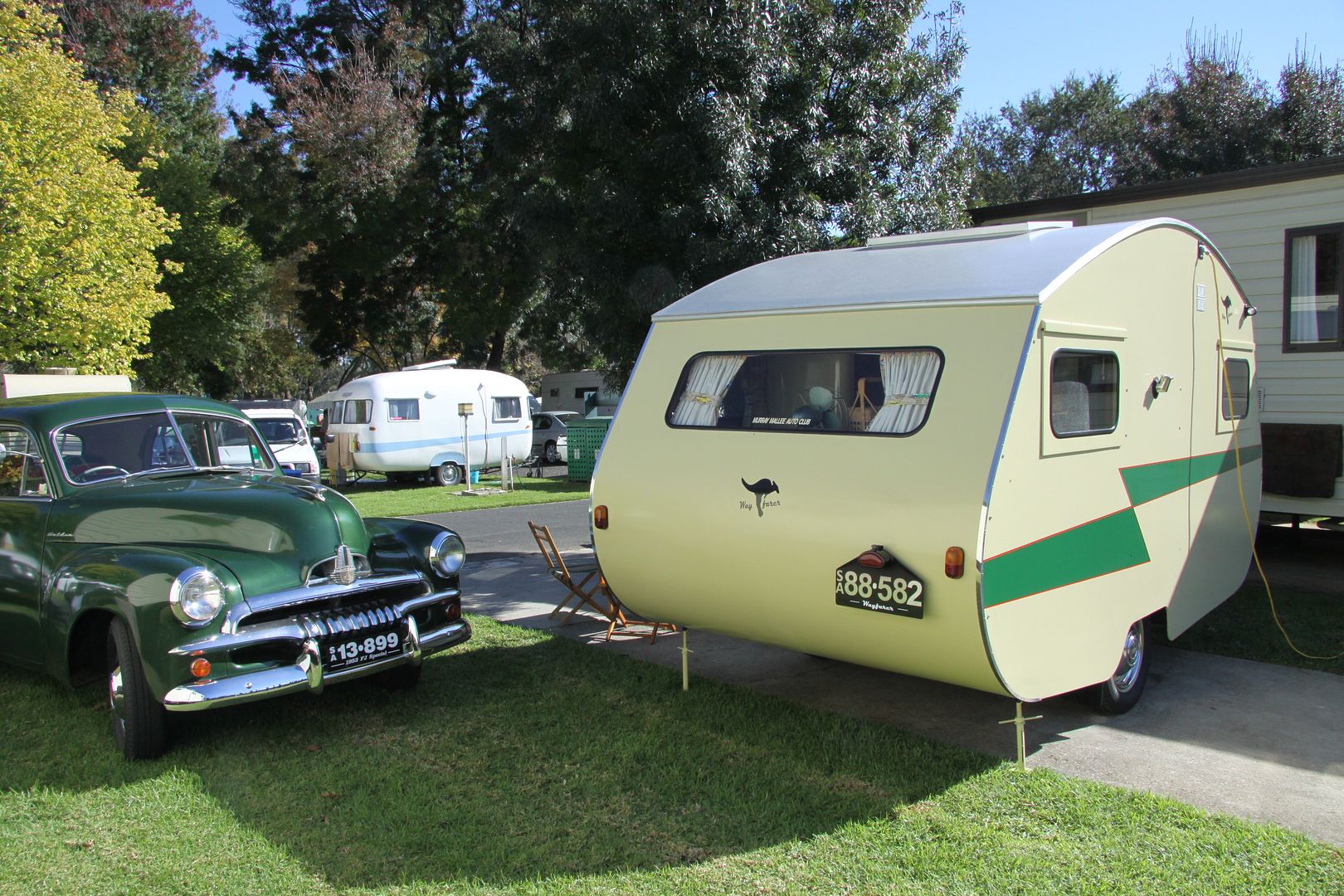 If Arthur01's legs are similar to these then I think it's possibly game over regarding the origins of his van, although I would still like to see photos of the ceiling to see if it's a tudor ceiling, and also a photo of the water tank to see if it is the type of tank Globe used pretty consistently until they started using pump taps. I've had a look at photos of quite a lot of Rowvans and found that there are almost no photos of them with their legs down, and in fact looking at the photos of the vans it is not easy to work out what sort of stabiliser legs they had. I did find one photo of a 15 ft Rowvan that you could clearly see had scissor type jacks at the rear which were operated from the sides. With that in mind, it seems to me from the photo below of the Rowvan (formerly belonging to Roehm3107) that it has the same kind of scissor type stabiliser legs that you can just see at each rear corner, and because of their direction they would have had to be wound down from the side: 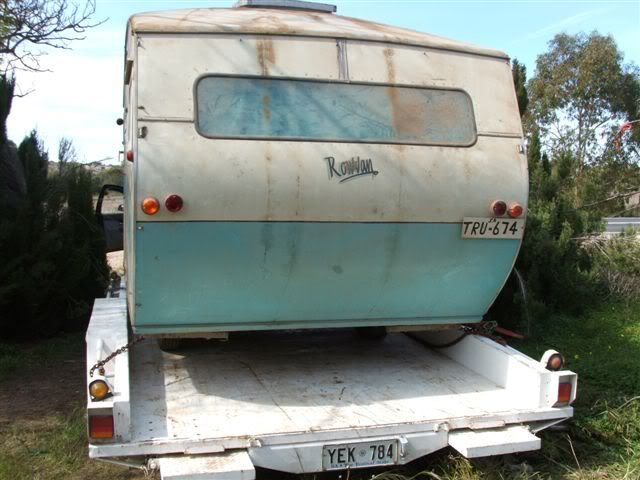 I can't find any photos which fit with your description of Rowvans having "sliding jacks in a sleeve that were in situ and you turned a knob and the inner sleeve dropped to the ground,where you then did up the knob to stabilise@. There's no sign of a knob in any Rowvan photos, and I'm actually wondering whether you're thinking of Furness caravans that had the knobs on the sides to let the legs down? Arthur01 has said that he has the stabiliser legs for his van, so let's see if he can tell us more, or show us photos. Don Ricardo |
|
|
|
Post by hughdeany on Oct 24, 2022 10:36:21 GMT 10
Hi Don,
Yes the Globe has their standard early type jacks,the Rowvan on the trailer has side winder jacks,but they aren’t scissor type it’s just one leg that winds down in two pieces.
The ones I mean were on earlier Rowvans and you had to put your hand up under the body to access the thumbscrew.
Cheers
hughdeany
|
|
|
|
Post by Don Ricardo on Oct 24, 2022 16:38:23 GMT 10
Hi Hughdeany,
That's interesting to read.
I do hope Arthur01 will come back to us with further information about his van and it's stabiliser legs. If he found them in the van, it sounds as if they are the Globe type.
Don Ricardo
|
|
|
|
Post by Don Ricardo on Oct 24, 2022 16:49:00 GMT 10
Hi again Arthur01, I realised that in amongst the discussion about your van, neither Hughdeany nor I have addressed the question you raised about when your van might have been built. Based on the shape of the van and the wooden framed windows, my thinking is that it would have been built in the first half of the 50's. By the second half of the 50's, most manufacturers - including Globe and Rowvan - had changed over from wood frames to aluminium frames for the windows. Your van has a stone guard on it. The profile of the aluminium cladding used for that was introduced around 1964, so that has been added later. You'll note that the stone guard on the green van I showed you was plain aluminium which was an earlier form of cladding used for stone guards. Hope that gives you a few more clues.    Don Ricardo |
|
|
|
Post by arthur01 on Nov 1, 2022 13:43:06 GMT 10
Hi Don
I did try to reply to an email that you sent me the other day and have only just logged back into my emails to see that it was not received and then saw that the email address was a no reply address.
Sorry, is there another email address that you could contact me on? I did try to post some pics on here but it would not allow me.
|
|
|
|
Post by Don Ricardo on Nov 1, 2022 16:40:01 GMT 10
Hi Arthur01, Sorry you couldn't email me. I sent my email to you via Proboards (ie the Forum platform) and it probably only gave you the 'No Reply' address option! Not very helpful, eh? But no matter, you can email me direct at: caravanhistory@gmail.com If you email me some further photos I'll be happy to post them for you. I'll also post your original photos in a larger format on the forum too. I hope that'll be ok? I'm looking forward to hearing more about your van. Some of these South Australian vans are a real mystery, and I'm hoping that one day we'll get a little clue that will reveal at least some of the answers to the mystery.    Don Ricardo |
|
|
|
Post by arthur01 on Nov 2, 2022 7:20:10 GMT 10
Hi Don
Yes happy for you to put the pics in a bigger format.
Just about to email you the same email that I tried the other day.
Thanks for your help and everyone else as well.
Arthur01
|
|
|
|
Post by Don Ricardo on Nov 2, 2022 13:32:35 GMT 10
Morning all, Arthur01 has emailed me with some additional photos of his grandfather's caravan for me to post on his behalf. He has also responded to some of the questions Hughdeany and I asked about his van above. 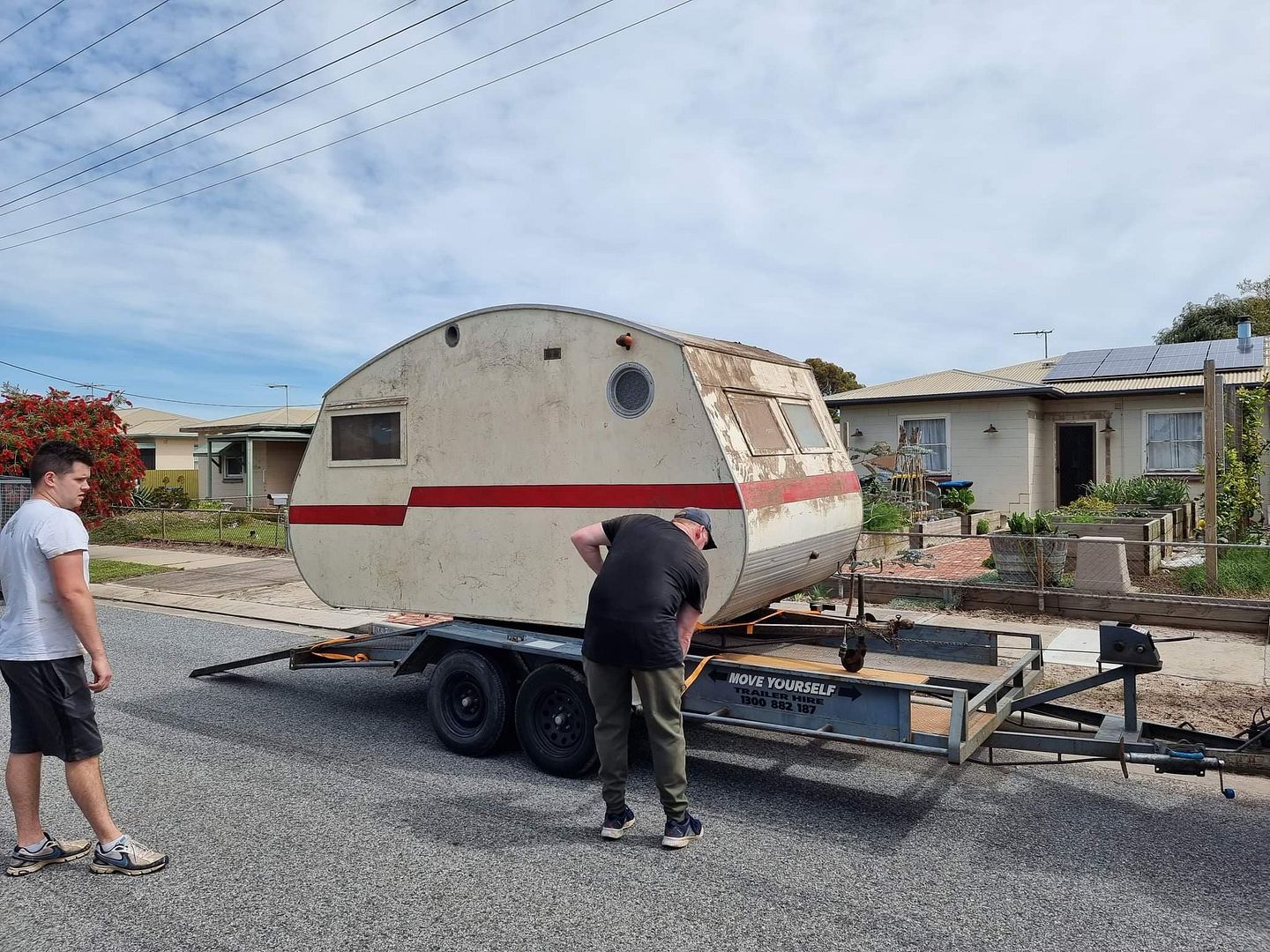 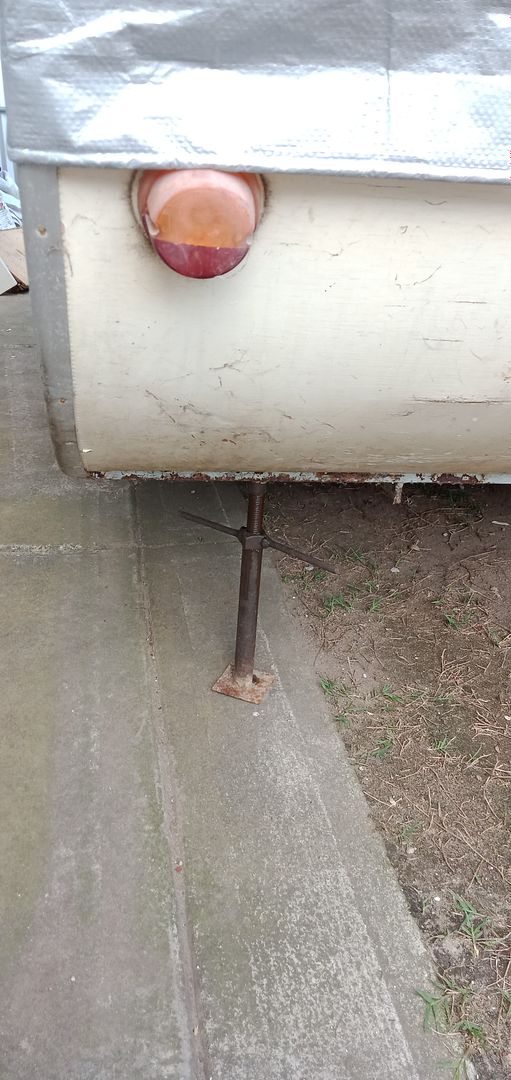  .jpg?width=undefined&height=undefined&fit=bounds) 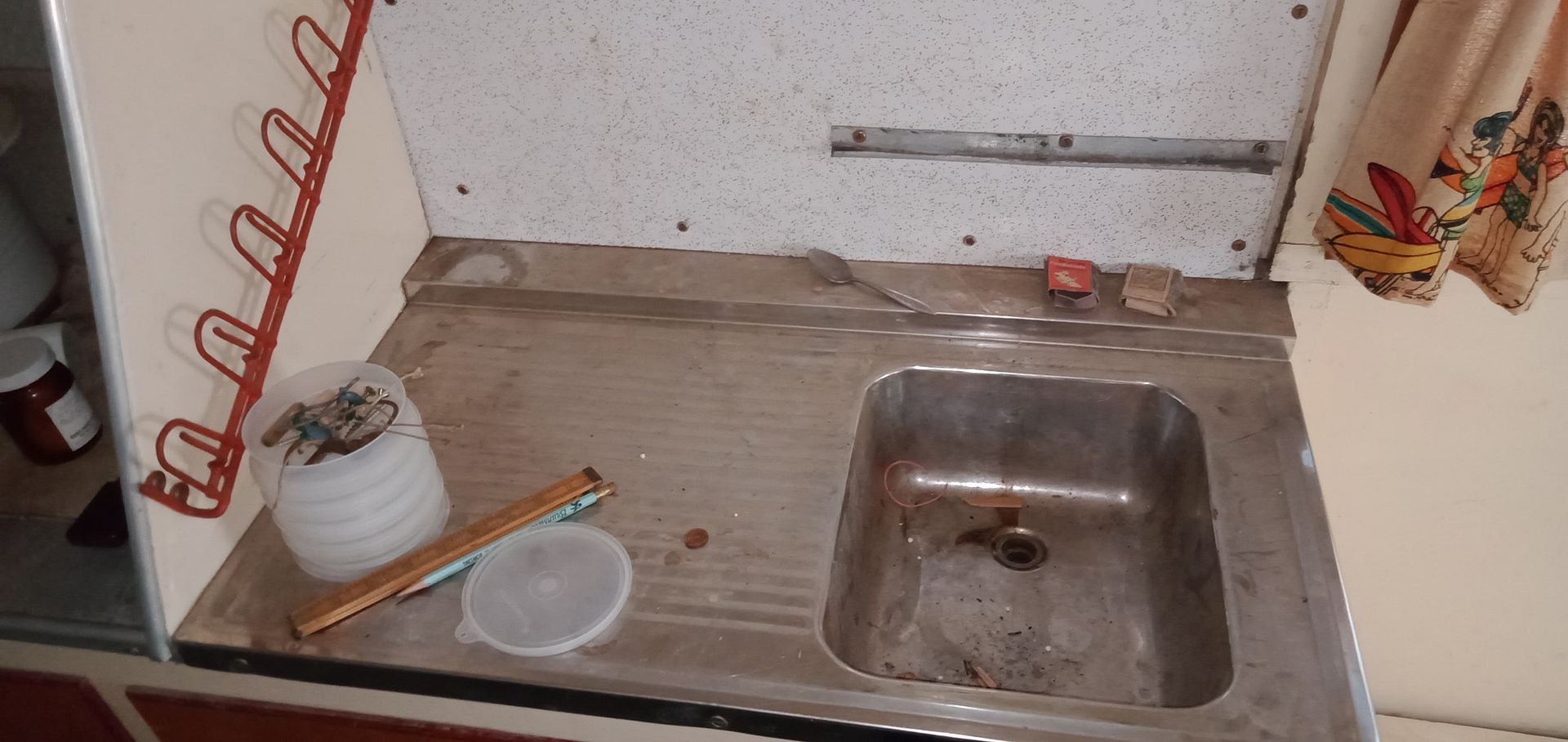 .jpg?width=undefined&height=undefined&fit=bounds) 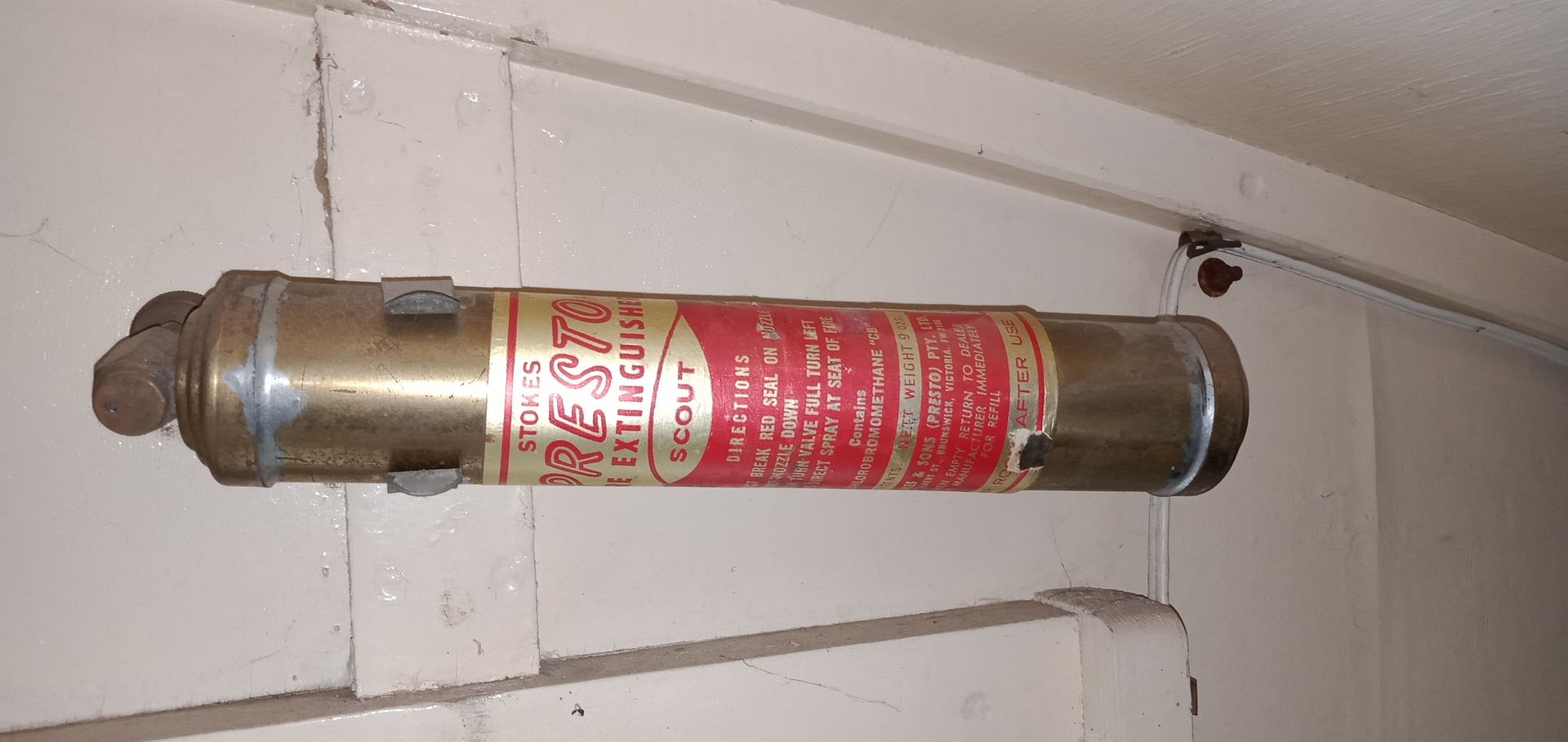 Arthur01 has also responded to some of the questions Hughdeany and I asked about his van in the posts above above: 1st Does the van have a 'tudor ceiling'?
No, the ceiling is covered by some more light ply wood. I haven’t opened it up so that is a slight guess as I cant see any roof struts.
2nd How far back on the roof is the roof hatch located on your van?
The roof hatch looks like it is right in the middle of the roof.
3RD Are the stabilizers portable?
Yes they are, please see the pic attached. Someone asked if I found the legs inside the van. Well the answer is no because they were holding the van up. It had been at my grandfathers house for as long as I can remember. The last time it had rego was June 1975. I was born in 1980 and have never seen the van move.
4th you asked to see the water tank
There is no water tank. It has no tap at all. I did find in some old pics on a thread that a container would sit in place just above the sink and this would have been portable. You can see in the attached pic of the sink were I think it used to clip in.
I think I have got all the questions from the post.
I have a few more things that might help.
The vans Rego plate is painted on, also from South Australia.
The mattress that I found in the van was made in South Australia.
All windows and the roof hatch has wooden flyscreens.
The paint job looks as if it was done by hand, pin stripes are not straight like it would be if taped up.
The tow hitch has Globe 601 welded on it. I thought that it might have been just for the hitch though.I think the photos and the details provided by Arthur01 pretty much confirm that the caravan is not a Rowvan, as indicated by the lack of a tudor ceiling, the placement of the roof hatch and the construction of the stabiliser legs, plus the other differences mentioned in the posts above. There are just too many differences between it and the style and features of Rowvans, which stayed pretty consistent from the commencement of Rowvan in the late 40's(?) right up to the late 50's when the company was taken over by Keith Odgers. However, the information from Arthur01 does also makes it virtually certain that the caravan was built in South Australia.
The flash/pinstripes on the sides were probably hand painted which would explain why they are a bit uneven.
As noted higher up this thread we had previously identified a van identical to Arthur01's as a possible Globe caravan, and it is interesting to observe that Arthur01's van has an older style Globe 601 coupling on it, as he has commented. However, several SA manufacturers used Globe produced and branded components...including Rowvan who Cobber has noted here did use Globe couplings! Nevertheless I don't believe that that is an indicator that Arthur01's van is a Rowvan. (For anyone interested, Cobber's post also includes some photos of a Globe 601 coupling from several different angles.)
Arthur01, I think I can see a serial number welded on to the side of the arm of the drawbar to the right of the registration certificate and almost out of the photo. Can you tell us what it is? It might provide another clue. You may need to rub some of the rust off the arm to decipher it, but the number seems to end in, or include '625'? Don Ricardo |
|
|
|
Post by arthur01 on Nov 3, 2022 7:16:06 GMT 10
Hi again people
I had a look for number but nothing came of it. I lightly took a wire brush to it and it was just old paint.
On the other hand I did find on the sink the name Cara Rest. Not sure if it would help with the year or identity of the van.
Arthur01
|
|